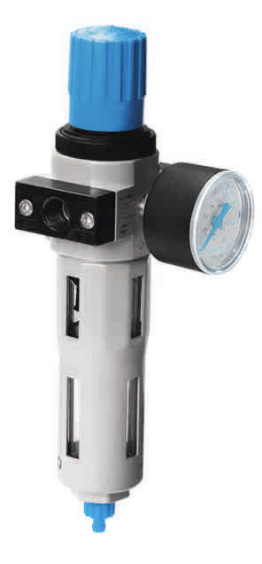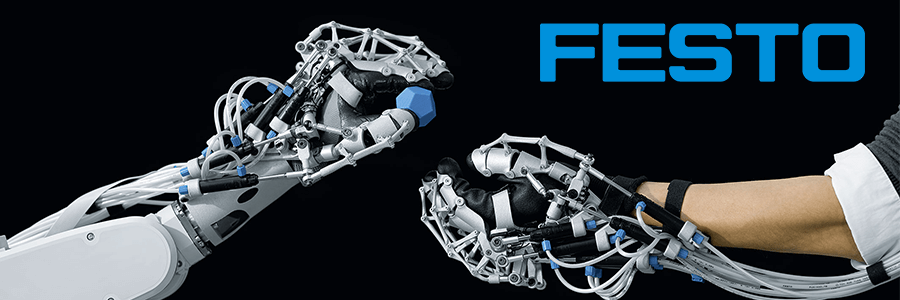Customer Service

To uphold optimal process reliability and machine uptime, meticulous preparation of compressed air must be integrated into the initial planning stages of the system. A pristine compressed air source, free from particles, water, and oil, serves as a safeguard against pneumatic component malfunctions, prolongs component lifespan, and mitigates machine breakdowns and operational downtimes.
Festo maintenance units are the core of compressed air preparation solutions. They ensure the right compressed air quality and filter compressor oil, condensate and dirt particles from the air. Depending on the application, a service unit consists of a pressure regulator, various filters, a branch module and pressurization and exhaust valves. Various combinations are available and in stock at Festo. In addition, service units can be configured individually in the MS modular system.


Raw compressed air is laden with contaminants, including particles, water, and oil, which can exist in various states—liquid or gaseous—within the system. These impurities never occur in isolation but form a complex mixture, the composition of which fluctuates throughout the system. For instance, water may accumulate in branch lines, while particles can amass in stagnant areas and later dislodge during pressure surges.
Every cubic meter of compressed air harbors millions of particles, along with substantial amounts of water, oil, and even heavy metals like lead, cadmium, and mercury. Failure to filter out these pollutants jeopardizes the sustained performance of system components and severely compromises product quality. Thus, meticulous preparation of compressed air is essential to mitigate machine failures, minimize downtime, and ensure both process and product reliability.
Compressed air must consistently meet cleanliness standards to prevent any operational disruptions or equipment damage. However, considering that each filtration step introduces flow resistance, it’s economically prudent to ensure compressed air cleanliness only to the extent necessary for its intended use. The diverse applications of compressed air necessitate varying levels of air quality, with higher quality air demanding multiple filtration stages.
ISO 8573 sets forth the cleanliness requirements for compressed air, delineating maximum allowable levels of solid particles, water, and oil content. Compliance with this standard has been obligatory for pneumatic automation since 2010, underscoring the importance of adhering to specific parameters for achieving energy-efficient compressed air preparation while meeting regulatory standards. Festo air preparation units and filters guarantee trouble-free function. You can find out which standard your application must comply with in our brochure “Reliable processes thanks to perfect compressed air preparation.”
This standard has been binding for automation using pneumatics since 2010. To ensure that compressed air preparation complies with the standard and is energy efficient, various parameters must be observed.
Many industries have strict requirements for compressed air quality. While the priorities for the food and packaging industries are food safety and problem-free consumption, PWIS-free compressed air is essential in paint shops. Festo service units and filters guarantee excellent functionality.
Some examples:
The compressed air is used for transporting or mixing, or in general food production. It thus comes into direct contact with the food.
If compressed air comes into direct contact with packaging materials for food, the packaging material is considered part of the food sector.
The following classifications apply for both applications: ISO 8573-1:2010
Particles = Class 1
Water = Class 4
Oil = Class 1
The compressed air is used for transporting or mixing, or in general food production. Therefore, it comes into direct contact with the food. Increased requirements apply in this case since air humidity plays an important role.
As a result, the following compressed air quality classifications in accordance with ISO 8573-1:2010 are recommended in these applications:
Particles = Class 1
Water = Class 2
Oil = Class 1
Compliance with the compressed air quality classes specified here is of great importance to guarantee maximum safety for the food and protect the health of the consumer.
Visual displacement encoders
e.g. in milling or machine tools require cleaning air with air quality class 1:4:1 in accordance with ISO 8573-1:2010 for a long service life. The high-purity compressed air is routed inside, preventing ingress of impure ambient air into the housing. That also means that oil mist cannot wet and damage the glassscale – a key requirement for a long service life of the displacement encoder. The filter combination for this: 5 + 1 + 0.01 μm + activated carbon filter
From highly sensitive applications in the pharmaceutical or food industry to application-specific solutions with sturdy flow performance for the automotive industry, the service units from the MS series are used almost anywhere, either centrally or decentrally.


The D series is available in sturdy metal for standard applications and basic logic functions for decentralized preparation. Or in the attractively priced polymer variant DB for reliable and economical compressed air preparation in uncritical environments. This is ideal for moving machine components, where low weight is required, for example.


E.B. Horsman’s dedicated PAC division has a close partnership with FESTO to ensure the team is fully equipped to assist with sizing and selecting the right components for your air preparation needs. We also lend application support with start-up and troubleshooting. Combining our full line of process, automation, controls & motion products with expert technical consulting to support your industrial needs. Contact us today for your FESTO needs:






Customer Service
1.888.467.7626